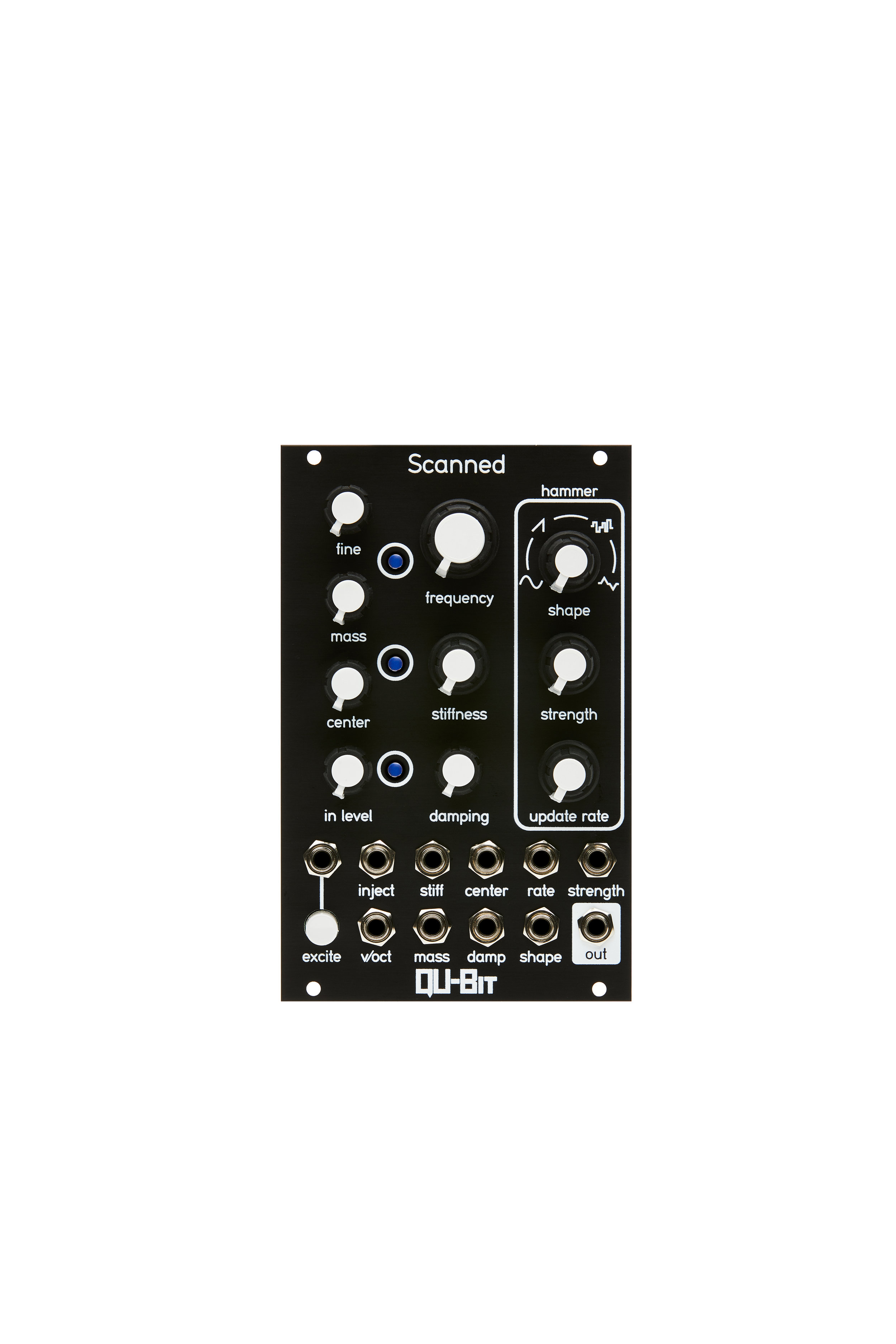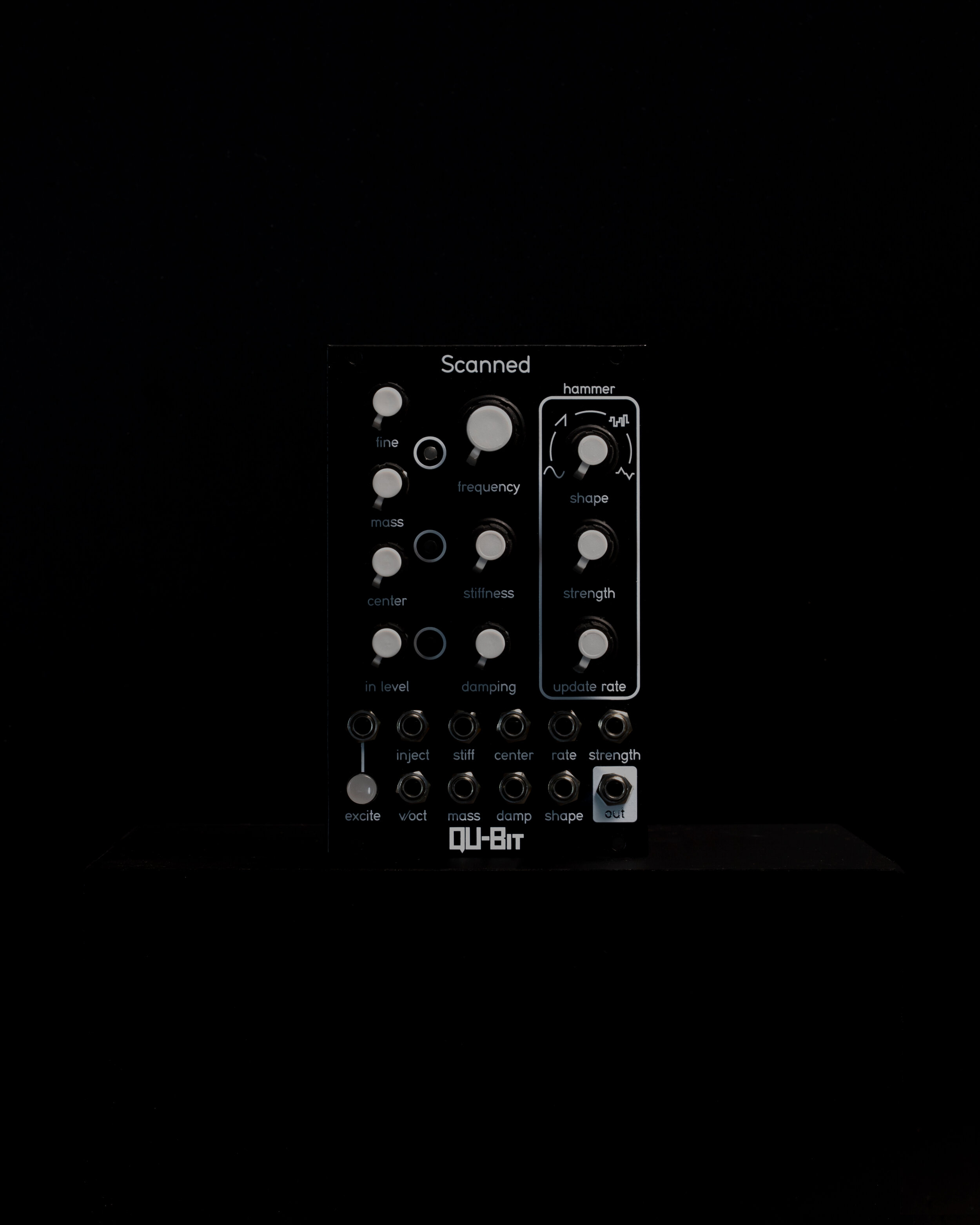Scanned
Scanned is an organic wavetable oscillator. It uses an unexplored technique known as Scanned Synthesis to animate wavetables that are created in real-time. This synthesis method was conceived by the father of computer music, Max Mathews, as the next paradigm in digital oscillators, and until now, has never been implemented on hardware.
The wavetables are dynamically generated from a set of "objects" tied together on a virtual string. These objects have physical properties including Mass, Stiffness, and Damping which affect the way that the string moves through space and time. Unlike physical modeling, however, this algorithm is a means of creating new electronic sounds, not replicating acoustic instruments.
To animate the waveform, the objects are morphed into the currently selected hammer shape and then released. This excitation of the sound generates evolving timbral landscapes that contain harmonic movement without external modulation. The hammer section also determines whether Scanned is a free-running oscillator, or a triggered sound source allowing it to function as a complete voice without additional filters or VCAs.
First hardware implementation of Scanned Synthesis
Organic wavetable generation and animations
Can be a free-running oscillator or triggered voice
Inject input allows external audio or CV sources to excite the string
Evolving timbral landscapes without external modulation
Four hammer shapes with interpolation
Aluminum front panel
Download the Scanned manual here
Tech Specs
Width: 16HP
Depth: 23mm
Power: 98 mA +12V, 13 mA -12V, 0 mA 5V
Scanned is an organic wavetable oscillator. It uses an unexplored technique known as Scanned Synthesis to animate wavetables that are created in real-time. This synthesis method was conceived by the father of computer music, Max Mathews, as the next paradigm in digital oscillators, and until now, has never been implemented on hardware.
The wavetables are dynamically generated from a set of "objects" tied together on a virtual string. These objects have physical properties including Mass, Stiffness, and Damping which affect the way that the string moves through space and time. Unlike physical modeling, however, this algorithm is a means of creating new electronic sounds, not replicating acoustic instruments.
To animate the waveform, the objects are morphed into the currently selected hammer shape and then released. This excitation of the sound generates evolving timbral landscapes that contain harmonic movement without external modulation. The hammer section also determines whether Scanned is a free-running oscillator, or a triggered sound source allowing it to function as a complete voice without additional filters or VCAs.
First hardware implementation of Scanned Synthesis
Organic wavetable generation and animations
Can be a free-running oscillator or triggered voice
Inject input allows external audio or CV sources to excite the string
Evolving timbral landscapes without external modulation
Four hammer shapes with interpolation
Aluminum front panel
Download the Scanned manual here
Tech Specs
Width: 16HP
Depth: 23mm
Power: 98 mA +12V, 13 mA -12V, 0 mA 5V
Scanned is an organic wavetable oscillator. It uses an unexplored technique known as Scanned Synthesis to animate wavetables that are created in real-time. This synthesis method was conceived by the father of computer music, Max Mathews, as the next paradigm in digital oscillators, and until now, has never been implemented on hardware.
The wavetables are dynamically generated from a set of "objects" tied together on a virtual string. These objects have physical properties including Mass, Stiffness, and Damping which affect the way that the string moves through space and time. Unlike physical modeling, however, this algorithm is a means of creating new electronic sounds, not replicating acoustic instruments.
To animate the waveform, the objects are morphed into the currently selected hammer shape and then released. This excitation of the sound generates evolving timbral landscapes that contain harmonic movement without external modulation. The hammer section also determines whether Scanned is a free-running oscillator, or a triggered sound source allowing it to function as a complete voice without additional filters or VCAs.
First hardware implementation of Scanned Synthesis
Organic wavetable generation and animations
Can be a free-running oscillator or triggered voice
Inject input allows external audio or CV sources to excite the string
Evolving timbral landscapes without external modulation
Four hammer shapes with interpolation
Aluminum front panel
Download the Scanned manual here
Tech Specs
Width: 16HP
Depth: 23mm
Power: 98 mA +12V, 13 mA -12V, 0 mA 5V
“If there are two things that you can say about Qu-Bit, it’s that the company has a wonderful habit of presenting modules which are just a little bit different, while maintaining a build quality which is up there with the best. However, the prospect of this new wavetable oscillator isn’t quite what you might expect from the humble description”






